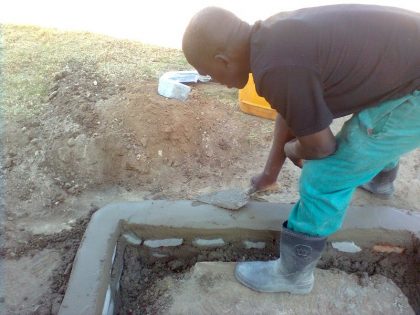 This project has been completed under the direction of Peace Corps Volunteer Alan Toth. To read about the beginning of the project, CLICK HERE.
This project has been completed under the direction of Peace Corps Volunteer Alan Toth. To read about the beginning of the project, CLICK HERE.
The project was to build a rainwater catchment and storage system at the school.
Alan reports:
I wanted to let you know that the project has been completed.
We started with buying materials for the project. We were able to get gutters, joiners, and downspouts. Unfortunately, due to a fuel strike, there was no supply of gutter brackets, so we were unable to mount the gutters. Instead, we continued with the base for the Jojo (cistern). We found some used cinder-blocks and with these, along with cement and river sand, we created the concrete base for the Jojo.
Once the fuel strike ended we were able to get a supply of gutter brackets, which were affixed to one of the roof beams along the edge of the corrugated iron roofing. Then the gutters were mounted in the brackets, joined with gutter joiners, and sealed with waterproof sealant.
The gutter downspout was connected to two curved spout pieces joined together to form an s-shaped pipe which lead into a final gutter segment attached the Jojo hatch. The s-shaped pipe and gutter-segment were attached to a wooden pole which was mounted into the ground to provide greater stability against the high winds.
A pipe and spigot were attached to the bottommost spout in the Jojo, and a warning not to drink the water was spray-painted onto the side of the Jojo.
I am still working on little things, painting signs, patching leaky gutter joints, and such, but the system is in working order. I am beginning classes and a puppet show for students about water conservation.
Yesterday my school had a meeting with the parents committee, which included about 50 parents from the village. They wanted to express their gratitude for the funds that made it possible for us to complete the project.
In regards to the project itself, they said:
“It is beautiful.”
Again, thank you for all the help.
We wish to thank Alan for completing this important project. By using collected rainwater for irrigation and hygiene, the delivered potable water can be available for its intended purpose. In addition, it can serve as an emergency supply, to be used for drinking if necessary with minimal treatment.
We again extend our gratitude to The Soneva SLOW LIFE Trust for providing the funding.





